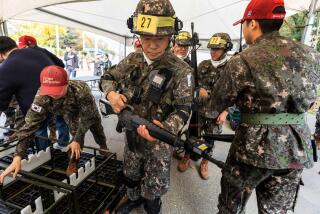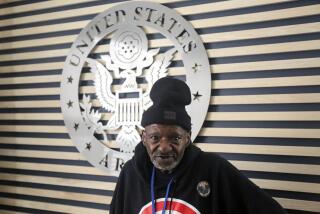The Cold Is Still an Enemy for Some Frostbitten Korean War Veterans
- Share via
FLINT, Mich. — Thousands of men who limped home from the Korean War, hurt not by bullets but by relentless subzero cold, are making painful discoveries four decades later. Frost-injured limbs that once got better unexpectedly are getting worse with age.
Veterans who quietly overcame their injuries are suffering today from new symptoms that include infections, skin cancer, joint deterioration and extreme sensitivity to cold. In the worst cases, men are losing limbs to amputation as infections settle into stumps and scars that lack healthy nerves and circulation.
Most of the afflicted are veterans who fought and froze on the windblown mountains above North Korea’s Chosin Reservoir--scene of a disastrous battle in which Allied forces were overwhelmed by invading Chinese and by temperatures hovering near 30 below.
“I always had problems, but I never paid too much attention to them until I got older, and I started getting worse and worse and worse,” said Ernest J. Pappenheimer, a former Marine gunnery sergeant who lost all his toes to frostbite and today leads a national advocacy group for cold-injured veterans.
“Any front-line soldier or Marine has got to have a problem. And I was probably more fortunate than most of the victims.”
Pappenheimer, 68, spends winters in Louisiana to escape the cold, returning each spring to his home in Michigan. Even now, at his lakeside house near Flint, his feet burn on chilly nights when the temperature dips below 50.
Year-round, his stumps and heels are prone to dangerous infections and wounds that won’t heal. And his joints “crackle like Rice Krispies,” a reminder of the deterioration caused by 45 years of walking on stubby feet.
The battle at the Chosin Reservoir lasted about a week toward the end of 1950, ending in retreat. It is assumed that nearly all the 18,000 Allied soldiers and Marines who fought there suffered frostbite or some “cold injury.”
Frostbite occurs when ice crystals form inside tissues, destroying cells and blood vessels as they expand. Although less extreme, cold injury is an insidious condition in which prolonged exposure constricts vessels--cutting off circulation like a tourniquet. Extremities can die from lack of blood flow even though they don’t actually freeze.
In either case, surviving tissues are often left with damaged blood vessels and nerves. Later, the natural forces of aging, such as impaired circulation, can make once-manageable ailments intolerable. No doubt, the phenomenon has been experienced by other frostbite victims--from veterans of ancient wars to children lost in snowy woods. But the victims were scattered by time and place, their symptoms poorly understood until a group of men who fought under the same extreme conditions came together.
It happened in a San Diego hotel in 1985. Several hundred veterans were gathering for the first meeting of a national organization called the Chosin Few. The former Marines and soldiers had met to reminisce. But as they looked around, they were dumbfounded.
“Everybody was having problems walking, getting up,” Pappenheimer said.
They complained of excess sweating, malformed toenails, infected stumps, skin cancer and cold sensitivity. Many had moved South to escape cold winters.
The revelation that cold injuries were revisiting so many veterans mobilized the Chosin Few.
Pappenheimer helped organize a committee that educates veterans and doctors about the latent effects of frostbite and cold injury.
The Chosin Few sent delegations to Washington, lobbying and finally persuading the Department of Veterans Affairs to change its outlook toward ex-servicemen disabled by the cold. The government now approves about 600 claims a year, many of them filed by veterans of Korea.
A turning point occurred in 1994, when the department agreed to stop denying disability payments to veterans who cannot produce evidence that their symptoms stem from their service at the front.
It was an important reversal because many troops had thawed out in first-aid stations and returned to battle without any record made of their injuries.
“Those who were exposed to extreme cold were probably put on a waiting list and perhaps were never seen,” said J. Gary Hickman, the VA’s director of pension and compensation services. “But we know from historical data that during that period, extreme cold had set in and you can be certain they were exposed.”
Although the government is approving some claims, the Chosin Few contend that the message has not filtered down to veterans hospitals and claims centers. They say doctors know little about delayed symptoms, and have unfairly dismissed complaints as psychological--even if the veterans fought at the frozen reservoir. This, they say, has led to unjust denial of many benefits.
Pappenheimer, a farmer’s son, wanted to make a career of the military. But in late 1950, five years after he enlisted, it was his misfortune to take part in the disastrous drive to the Chinese border--a move that drew half a million Chinese troops into the war and thrust Allied troops into the region’s coldest winter on record.
Nowhere were conditions worse than at the Chosin Reservoir. There, U.N. troops were encircled for more than a week, beset by nighttime ambushes and piercing cold.
“It was a living hell for those troops,” Pappenheimer recalled. “Warming tents? What warming tents? Hot food? What hot food? You know, if you built a fire on the front lines, it would give away your position exactly.”
Inside sleeping bags, a person’s exhalations would condense and freeze zippers shut. Trapped, some Marines and soldiers were bayoneted where they lay. Others used the bags as blankets and slept directly on frozen ground.
The troops were given “shoe pacs”--rubber boots with woolen socks and felt liners. They were supposed to change into spare socks and liners to prevent perspiration from turning to ice.
“But when you’re in combat, you don’t have time for this,” Pappenheimer said.
In the nearby village of Hagaru-ri, Dr. Stanley I. Wolf, who now has an allergy practice in Montgomery County, Md., was a young Marine doctor at a first-aid station. Many of the wounded arrived strapped to the hoods of jeeps or to the sides of artillery.
“We had multiple gunshot wounds and frozen feet and guys with half their heads shot away,” he said, stopping to compose himself. “It was probably the most difficult time of my life.”
Pappenheimer was shot through the neck. Later, he broke a rib when men carrying his stretcher stumbled and dropped him over an embankment. He was evacuated in a crowded helicopter, his feet dangling outside. They froze like bricks.
Once discharged, he spent a year healing and learning to balance on shoes outfitted with steel and cork inserts. A job servicing vending machines led to a career as president and part-owner of a novelty ice-cream company.
He has battled pain since he was injured at 23, but says his troubles escalated in his 50s.
His extremities are so sensitive to cold that he can’t tolerate an air-conditioned car in the summer. His gait is uneven--even tipsy--until he gains momentum.
When Pappenheimer talks about being “fortunate,” he is thinking about people like Donald F. McAlister of Stockbridge, Mich.
An Army corporal, he was shot twice, beaten and left for dead. When he revived, he staggered to safety across the frozen reservoir on feet that felt like “a couple chunks of ice.” He lost toes, heels and four fingers.
For years, he drove bulldozers and backhoes equipped with fans that blew heat onto his legs.
“I gritted my teeth until 1990,” McAlister said. That year, an infection that had festered in scar tissue on his right foot entered his bone--forcing doctors to amputate below the knee.
Pappenheimer, whose disability was recognized shortly after the war, receives about $1,000 a month in compensation. Now, he helps others navigate the claims process.
In his Michigan home, he keeps files on more than 300 veterans. Many have spent years seeking benefits.
The government compensates about 30,000 people for disabilities resulting from frostbite and cold injury, according to the VA. They include veterans who survived the prison camps and battlefields of World War II as well as Korea.
Despite progress, Pappenheimer is facing a deadline. Some of his files bear gold stars signifying those who died. “Let’s face it,” he said. “Time’s running out on this group.”
More to Read
Sign up for Essential California
The most important California stories and recommendations in your inbox every morning.
You may occasionally receive promotional content from the Los Angeles Times.










